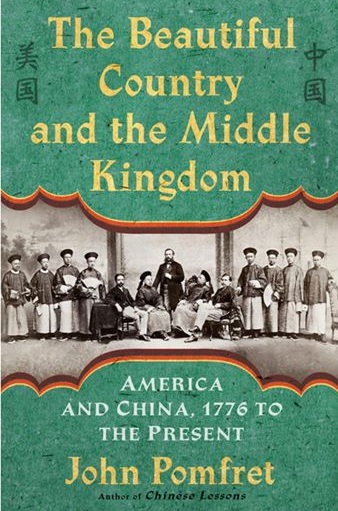 THE BEAUTIFUL COUNTRY AND THE MIDDLE KINGDOM: AMERICA AND CHINA, 1776 TO THE PRESENT
THE BEAUTIFUL COUNTRY AND THE MIDDLE KINGDOM: AMERICA AND CHINA, 1776 TO THE PRESENT
By John Pomfret
Henry Holt, $40, 693 pages
Trying to understand China has been compared to gazing into jade. Cloudy and yet softly glowing, jade, in the words of the great Japanese novelist and essayist Tanizaki Junichiro, “quite lacks the brightness of a ruby or an emerald or the glitter of a diamond. But this much we can say: When we see that shadowy surface, we think how Chinese it is, we seem to find in cloudiness the accumulated sediment of the long Chinese past, we think how appropriate it is that the Chinese should admire that surface and that shadow.”
Author and foreign correspondent John Pomfret concentrates on what is, by Chinese standards, a mere blinking of an eye: the era between the present day and 1776 when the ancient Middle Kingdom began a complicated, ambivalent interaction with what was then the world’s youngest nation. But even contemplating this brief interval of Chinese history is a jadelike study of surface and shadow — of shared hopes and illusions — all shaped by that “accumulated sediment of the long Chinese past …”
In 693 fact-filled pages rich in detail but driven by a lively narrative style, Mr. Pomfret brings alive a fascinating cast of characters with good judgment and sympathetic imagination. This reviewer was pleasantly surprised by the clarity and fairness with which Mr. Pomfret treats figures like Generalissimo Chiang Kai-shek, a flawed but sincere soldier-statesman trying to unify and modernize his country while fighting a war to the death with the Japanese — and while Mao’s communists engaged in political sabotage, “gleefully celebrated each of Chiang’s defeats,” and, in the words of a Russian adviser at Mao’s headquarters, “have long been abstaining from both active and passive action against the [Japanese] aggressors.” Mr. Pomfret also chronicles the constant vilification of Chiang and praise for Mao as an “agrarian reformer” by pro-Mao factions in the State Department and “progressive” stooges like Vice President Henry Wallace.
The result is a work that is both outstanding, in-depth journalism and an excellent “first draft” of history when dealing with contemporary and near-contemporary events. Mr. Pomfret has an eye for colorful characters and telling quotes. He even has a justifiably kind word for Cixi, the cunning Manchu concubine who gained western notoriety as the Dowager Empress. “Western historians … have generally portrayed her as a scheming autocrat who stymied reforms. But to be fair, she had an impossible job, trying to steer a course between grasping imperialists and competing factions at court.”
Among her wiser advisers — whose influence was enhanced by the fact that he was also one of her lovers — was the Manchu prince Gong, one of the first Chinese to distinguish between the predatory imperialism of the Russians, Japanese and major European colonial powers, “barbarians” all, and Americans interested only in trade and missionary work. The latter, while it never came close to mass conversion of the Chinese, was indispensable to introducing modern knowledge and western science and medicine through its schools and hospitals. “The American barbarians,” Gong wrote in an 1861 memorandum, “are pure-minded and honest in disposition and have always been loyal to China. The problem is how to control them to make them exploitable by us.” That problem, Mr. Pomfret wryly observes, “would perplex Gong and his intellectual descendants for the next 130 years.”
“The Beautiful Country and the Middle Kingdom” is about much more than the official relationship between Washington and Beijing. It is also the story of the American Dream of legions of ethnic Chinese who came to the “Beautiful Country,” overcame incredible barriers and built good lives, and of the remarkable progress of other overseas Chinese. “The extraordinary success of the Chinese in America and Taiwan’s march to full democracy exemplified the harmonious melding of American values and Chinese culture. Here in action was the Great Harmony that many Chinese and Americans had sought for years.”
Even on the Mainland, despite Mao’s early purges, the madness of the Cultural Revolution, and the periodic, almost seasonally predictable changes in Sino-American strategic relations, more and more middle-aged and younger Chinese officials and technocrats are the products of a post-ideological society (admittedly still ruled by an ideological state structure). And more and more children of the governing elite are doing their university and postgraduate studies in leading American universities.
The result is a delicate but — so far — practical balance in Sino-American relations. “Both sides are often guarded, sometimes hostile,” Mr. Pomfret concludes, “but overall they are accommodating.” Like Felix and Oscar, China and America will always be an Odd Couple, but one that shares a number of ties and interests in common.
• Aram Bakshian Jr., an aide to Presidents Nixon, Ford and Reagan, writes widely on politics, history, gastronomy and the arts.
